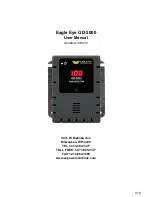
15
SEARCH MODES
Your CZ-21 has two search modes: Target I.D. and Autotune. Both
search modes are “motion” modes, meaning the search coil must
be in motion to detect a target.
Unlike other metal detectors, the
discrimination level has little, if any, effect on the depth capability
of the CZ-21. Note, however, that the all-metal Autotune mode has
a wider search pattern and may detect a little deeper. Depth is
also determined by the size, shape and conductivity of the target
as well as the sensitivity setting of the CZ-21.
AUTO TUNE MODE
Set the DISC control to AUTOTUNE, for a very sensitive, wide-
scan, all-metal, motion search mode. This mode responds to all
metal targets and does not have the ability to identify or reject
objects.
The Autotune mode is useful in three situations:
1. Non-Trashy Areas.
The Autotune mode has a wider
scan than the I.D. mode, reducing changes of
missing good targets. Search in the Autotune mode
until you find a target. Pinpoint the target using the
PINPOINT button and then switch the DISC control
to “0” to identify the target in Target I.D. mode. The
DISC control is positioned so that you can switch back
and forth between AUTOTUNE and “0” with a flick of
your thumb.
2.
Highly Mineralized Soil or Sand
. The Autotune mode
is recommended for black and gray beaches or
highly mineralized soil. Under these conditions it
may be necessary to lower the sensitivity level and
sweep several inches off the ground (see the notes
on p. 14) Gold nuggets are generally found in highly
mineralized soil so this will be the search mode of
choice for prospectors.
3. All Metals Searching.
Evidence recovery teams,
archeologists and professional underwater treasure
hunters will often opt for the deep search, all-metals
Autotune mode.
26
a feel for which target classifications will be the most
productive.
13.
Look for repeatable signals and don’t waste time
on disappearing or one-way signals. If you hear a
good beep but can’t repeat it when you go back
over the target area, or if it beeps in only one sweep
direction, it’s probably a piece of trash - something
below your discrimination setting.
14.
If you’re in a relatively non-trashy area, try searching
in the Autotune mode and then identifying your
targets by switching to DISC = “0.” You’ll find more
and deeper targets this way.
And you’ll eliminate
almost all false signals.
If you’re having any difficulty
pinpointing or identifying a target in the I.D. mode,
don’t waste any more time. Push the pinpoint button
for quick pinpointing, then release it for accurate
I.D.
15.
If your target disappears when you go into the Pinpoint
mode, you’ve probably tuned it out by pressing the
button too close to the target or over another piece
of metal. Try again, this time tapping the PINPOINT
button over another piece of ground.
16.
Don’t waste a lot of time digging holes for targets
you can’t find. If your hole keeps getting deeper
and wider, cover it up and go on. You may be over
a buried pipe or some other large deep target.
TARGET IDENTIFICATION





































